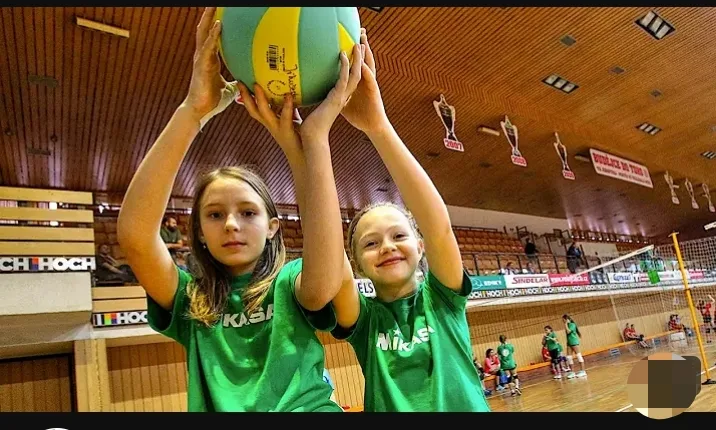Here are 20 basic volleyball rules for kids that will help them understand how to play volleyball.
Volleyball is a fun game that can be played both indoors and outdoors. It’s also a game that can be enjoyed by all; therefore, children too can play the game.
Volleyball is a game between two teams; however, the number of players per team depends on the type of volleyball game. An indoor volleyball game consists of two teams of six players each, while an outdoor game, which is the beach volleyball game, consists of two teams of two players each.
To begin the game, one player from either team serves the ball over the net, then the receiving player attacks and defends by hitting the ball back.
The receiving team has three chances to touch the ball and return it to its opponent. They also have to make sure that the ball does not touch the ground, because if it does, then the point goes to the other team. The first team to reach 25 points becomes the winner of the game.
There are certain laid-down rules for those interested in the game of volleyball. It is important to abide by the rules in order not to commit a foul and be disqualified from the game.
Children are not exempt from the rules because, even though they are just kids, it is a must that they stick to the rules of the game.
In this article, we will be discussing fundamental volleyball rules for kids. Ensure you read to the end. Before we begin, Let’s start with 10 volleyball rules for beginners.
Related article:
- Volleyball Players Positions and Roles Explained
- Terms in Volleyball with Definitions
- Basic Skills in Volleyball
10 Volleyball Rules for Beginners

Here are 10 essential rules for beginners to help you get started
#1. Six Players on Each Team
- Teams: Each team has six players on the court.
- Hits: Each team can hit the ball up to three times to send it back over the net.
#2. Match Play
- Sets: Matches are usually best of 3 sets, sometimes best of 5.
- Points: Each set goes up to 25 points, but you must win by 2 points.
- Deciding Set: In middle and high school, the last set may go to 25 points. In college, it goes to 15 points with a side switch at 8 points.
#3. Serving from the end line
- Serve: The serve must be made from behind the back boundary line.
- Net: The ball must go over the net into the opponent’s court.
#4. A ball can touch the net
- Net Contact: The ball can touch the net during a serve, but it must still go over.
#5. Scoring Points
- Points: Points are scored when the ball lands in the opponent’s court, the opponent hits the ball out, or the opponent commits a fault.
#6. The court boundary line is in
- Boundary: If the ball lands on the boundary line, it is considered in.
- Serve: The team that wins the point serves next.
#7. Rotate After Winning a Point
- Rotation: After winning a point on a serve, the receiving team rotates clockwise.
- Server: The player who served last rotates to the back middle position (zone 6).
#8. No catching or throwing
- Rally: The ball must not be caught, thrown, or carried. It should keep moving without stopping in the player’s hands.
#9. Net Violations
- Net Touching: Players must not touch the net during play. This is a fault and gives a point to the other team.
#10. Libero can’t play front row.
- Libero Position: The libero is a special player who can only play in the back row.
- Replacement: When the libero moves to the front row, they must be replaced by the player they initially replaced. This does not count as a team substitution.
These 10 basic rules will help you, as a beginner, understand and enjoy playing volleyball. Now let’s look at basic volleyball rules for kids.
See Also:
- Beach Volleyball vs Indoor Volleyball: Similarities and Differences
- Volleyball Nutrition – Best Foods and Eating Habits for Players
- Top 10 Best Volleyball Players of all Time
- Best Volleyball shoes, Review of different Volleyball shoes 2024
- Volleyball Tryouts: Evaluation Form & Tips for Selection
- Volleyball Guide for Pregnant Women (Can you play volleyball while pregnant)
Volleyball for Kids: Basic Volleyball Rules for Kids

- Do not touch the ball twice in a row: A team only has three chances to touch the ball; however, one person cannot touch the ball twice in a row.
- Do not carry the ball around. You are not allowed to run with the ball or carry it around. You are only to hit the ball in defense, or probably if you want to serve the ball. Carrying the ball is regarded as a foul.
- Do not leave the side of your net. Ensure to always be on your own side of the net, especially when trying to hit the ball. You will be fouled if you attempt to leave the side of your net.
- Never try to interrupt a game. Ensure not to disrupt a game when the referee has not yet blown his whistle. Once you do, you will be disqualified.
- Stepping on or over the boundary lines is not allowed. As a player of the game, make sure you always take note of the boundary line. Sometimes trying to hit the ball or attack the ball can make you forget the boundary. However, it is crucial that you are conscious of the demarcation because stepping on it is considered a foul.
- Do not touch the net or court with any part of your body. Touching the net with any part of your body is not allowed. The only thing allowed to touch the net is the ball.
- Crossing under the net is disallowed: You are not allowed to cross under the net at any point in the game. It is not allowed and will be considered a foul if you do so.
- You are only to make contact with the ball on the side of your net. Try not to touch the ball once it has left your own side of the net.
- Always serve from the end line: The ball should always be served from the back boundary line and into the opponent’s side of the court.
- A player cannot abuse an opponent verbally.
- A team cannot substitute more than once during a single dead ball.
- A team cannot have more than six players on the court at any time. This is if it’s an indoor volleyball game, but if it’s beach volleyball, then the players must not be more than two.
- A player is not allowed to play with any hard objects in their hair.
- Every player is instructed to wear the right uniform, as a player will not be allowed to play.
- A player cannot attack the ball on the opponent’s side when the entire ball is on the other side of the net.
- Serving from outside the serving zone is highly prohibited.
- A teammate of the server must not make contact with the ball before crossing the net.
- The ball must not touch the antenna during play.
- The ball must not touch any object or any other area outside the court.
- A team cannot have more than one libero on the court at a time.
The above-mentioned volleyball rules help kids enjoy the game on another level. Just like every game has rules, so does volleyball; hence, to enjoy the game to the maximum and avoid being disqualified, it is important to obey and abide by the rules.
See Also: Volleyball Game for Kids: 10 Best Volleyball Games to Keep Kids Engaged




